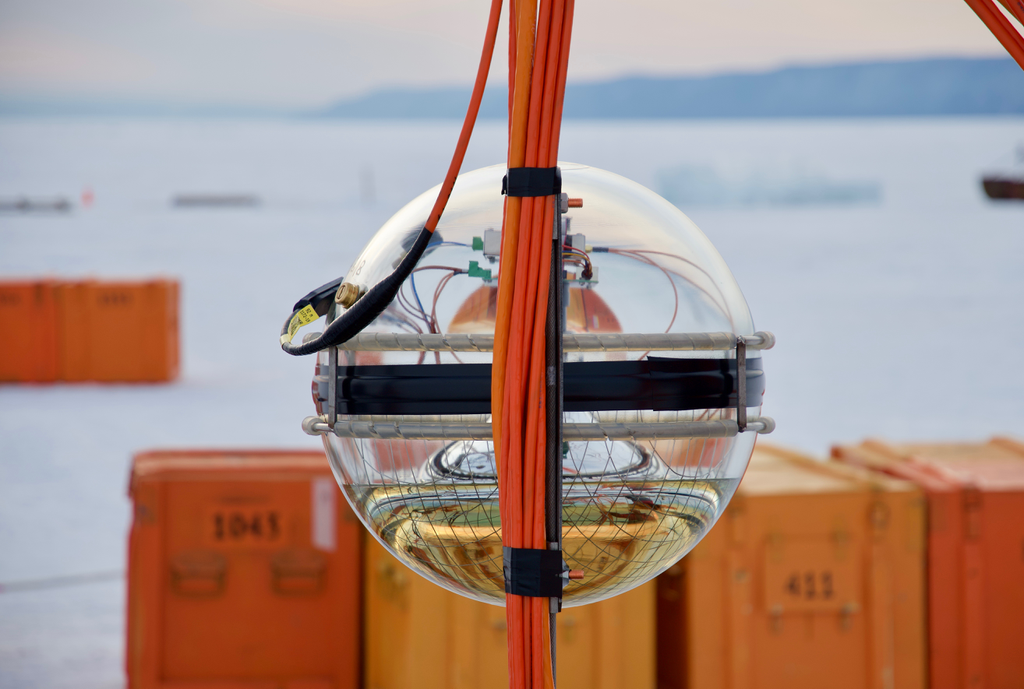
Photo: BAIKAL-GVD
During 2022-2023, the United Engine Corporation of Rostec will anneal 2,100 permalloy screens for the observatory sensors, which will enable a 50% increase in its sensitivity. Neutrino telescope sensors positioned in the waters of Lake Baikal capture high-energy particles and identify their sources. This allows scientists to study events happening in deep space.
The neutrino telescope is a network of several thousand optical recorders immersed in Lake Baikal at a depth of about 1,000 m, where the recording of high-energy neutrinos is carried out. A unique feature of these particles is their ability to travel astronomical distances preserving the movement direction, thereby they convey information originating from the farthest areas of the Universe. The purity of the Baikal water makes it possible not only to capture neutrinos, but also to determine the source of their origin with great accuracy.
“The Baikal Neutrino Telescope is one of the largest astrophysical facilities not only in Russia but also worldwide. Since 2016, Rostec has been involved in manufacturing screens for the observatory sensors. They are made of special permalloy composition, which prevents the distorting effects of the Earth’s magnetic field on the detectors. To acquire the required properties, the screens must be annealed in vacuum furnaces of quite a large volume. Rostec’s enterprise possesses unique competencies needed for operating such equipment. During this period, we have delivered over 3,800 items. In the next two years, we will ship 2,100 screens to scientists on Lake Baikal, which will increase the telescope’s sensitivity volume by 50%,” said Oleg Yevtushenko, Executive Director of Rostec State Corporation.
The screens are annealed by the Salyut Production Complex (part of Rostec’s UEC). The sensitivity volume of the Baikal Deepwater Neutrino Telescope increases annually by two clusters, or more than 600 optical recorders. It is planned to reach a volume of 1 cubic kilometer by 2024, with a significant improvement in its neutrino capturing performance.
On December 8, 2021, the neutrino telescope of the Baikal Collaboration witnessed a unique astronomical event: a radio blazar outburst, which may indicate intense processes in a far-away emerging galaxy. The event was first recorded by the Antarctic IceCube telescope, as well as by various measuring devices located in different parts of the planet and operating in a wide variety of electromagnetic radiation regions.
“From the scientific perspective, this is a completely unique phenomenon: never in history have two neutrino telescopes actually identified two different neutrinos coming from the same source in real time, and it also coincided with the activities of this radio blazar in all electromagnetic frequency ranges. Such coincidences have never occurred before, because the neutrino telescope was just being put into operation, and it was too small. This very event proves that the neutrino telescope of the Baikal Collaboration now has enough power to capture such meaningful phenomena. We can say that it joined the league of heavyweights who can do astronomy of this scale. This is a very important event for the Baikal Collaboration and for all of us,” noted Dmitry Naumov, Deputy Director of the Laboratory of Nuclear Problems of the Joint Institute for Nuclear Research, head of the neutrino program, Doctor of Science in Physics and Mathematics.
The neutrino observatory is operated by the Baikal International Collaboration, which includes the Institute for Nuclear Research of the Russian Academy of Sciences (RAS), the Joint Institute for Nuclear Research, Irkutsk and Moscow State Universities, the Institute of Nuclear Physics of the Czech Academy of Sciences, the University of Bratislava, and a number of other Russian and foreign research organizations.

